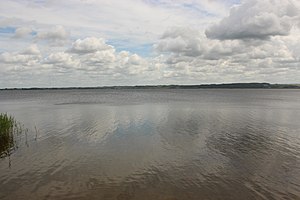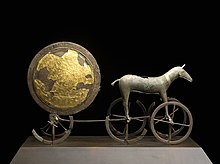Wetlands and islands in Germanic paganism
Scholars have argued that during the 5th century CE, the religious importance of watery places was diminished through the actions of the newly forming aristocratic warrior class that promoted a more centralised hall culture.
Their cultic role was further reduced upon the introduction of institutionalized Christianity to Germanic-speaking areas when a number of laws were issued that sought to suppress persisting worship at these sites.
Despite this, some aspects of heathen religious practice and conceptions seem to have continued after the establishment of Christianity through adaptation and assimilation into the incoming faith such as the persistence of depositions at holy sites.
[3][4][5][6] Throughout this long period there was significant regional and temporal variation with different sites favouring deposition of different types of items at different points in time.
[17] The gradual reduction of wetland depositions around the 5th century CE has been linked by Terry Gunnell with the centralising of religious traditions and the rise in prominence of halls and the male warrior elite.
He further proposes that during this period, female figures associated with bodies of water reduced in prominence and their conception as rulers of realms of the dead was replaced by developing ideas of Valhöll.
[25] Consistent with this, the Byzantine De Administrando Imperio describes the Rūs Vikings performing sacrifices on St. Gregory's Island in the Dnipro river, which has been linked to finds of Scandinavian swords in the region.
[26] Other written accounts include that of the 10th century Andalusian traveller Ibrahim ibn Yaqub that describes those living in Hedeby would throw excess children into the sea.
[27] The deposition of weapons in wetlands may be reflected in names of rivers in Nordic mythology such as Geirvimul ("The one bobbing with spears"), Nöt ("The stinging") and Sliðr ("The dangerously sharp").
Among the sites with the most discovered weapons is the Danish lake Tissø, by which a settlement has been further found that could only be reached in the Viking Age using a 50 m long wooden bridge.
[25] As with those imposed previously, laws issued in England by Cnut the Great between 1020 and 1023 CE forbade the worship of rivers and wells or springs, consistent with the archaeological record of depositions at those wetland sites.
Weapon sacrifices are often believed by scholars to be performed by the victors, thanking the gods by giving them the defeated side's war gear.
[35] On the contrary, it has also been argued that infanticide was socially acceptable due to factors such as the high infant mortality rate, not seeing children as full humans until they reached certain milestones like first breastfeeding and it being safer to the mother than abortions.
[36] Similarities have been noted between the contemporary practices of infant deposition in wetlands and those in spaces in settlements, such as in postholes and beneath hearths, which were more common.
[8] Notable outliers to these reasonings include the Skuldelev ships, which were intentionally scuttled for defensive purposes, blocking the entrance to Roskilde fjord, rather than serving a religious function.
[70][71] The conception of lands of the dead being separated from those of the living frequently recurs across the world and is attested throughout Northwestern Europe from the 6th century CE onwards.
Similarly, in the prose section of Frá dauða Sinfjǫtla, a boatman identified by some scholars as Odin ferries the body of Sinfjǫtli across a fjord.
These textual sources have been connected with wider evidence such as archaeological finds of ship burials that occur in Northern Europe from the Iron Age, likely reflecting the idea that those who had died could reach the land of the dead by boat.
[73] It has been suggested that bodies of water such as Odensjo were conceived of as passages to the otherworld where gods and other beings resided, similar to beliefs associated with saajve in south Saami tradition.
[52] Adam of Bremen describes in Gesta Hammaburgensis ecclesiae pontificum that at the temple at Uppsala, heathen sacrifices were made at the site of a tree and a spring or well (fons).
[76] It has been argued that the use of watery places should be seen in the context of the wider holy landscapes in the minds of the Germanic peoples that also included other important features involved in religious practice such as burial mounds, temples, hills, fields and groves.







